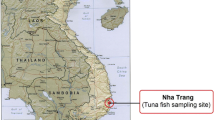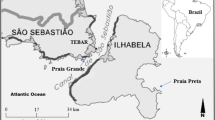Abstract
Concentrations of several trace elements were detected in the sediments at King Talal Dam and at different locations along the Zarka River, Jordan. Chemical elements were also detected in the edible part of common fish types existing at the dam. Elemental concentrations were determined using neutron activation analysis (NAA). The results showed that the concentration of chemical elements in the sediments decreases as one moves away from the Khirbet Al Samra waste water treatment plant. The results also revealed that most of the elements had higher concentrations in Tilapia fish compared to the Catfish.




Similar content being viewed by others
Change history
07 September 2017
An erratum to this article has been published.
References
Fandi KG, Qudsieh IY, Muyibi SA, Massadeh M (2009) Water pollution status assessment of King Talal Dam, Jordan. Adv Environ Biol 3:92–100
Al-Wer I (2009) The Zarqa River rehabilitation and sustainable management. A Master’s thesis submitted to the Department of Land and Water Resources Engineering, Royal Institute of Technology (KTH). Stockholm, Sweden
Adomako D, Nyarko BJB, Dampare SB et al (2008) Determination of toxic elements in waters and sediments from River Subin in the Ashanti Region of Ghana. Environ Monit Assess 141:165–175. doi:10.1007/s10661-007-9885-x
Wright P, Mason CF (1999) Spatial and seasonal variation in heavy metals in the sediments and biota of two adjacent estuaries, the orwell and the stour, in eastern England. Sci Total Environ 226:139–156. doi:10.1016/S0048-9697(98)00383-0
Abderahman N, Abu-Rukah YH (2006) An assessment study of heavy metal distribution within soil in upper course of Zarqa River Basin/Jordan. Environ Geol 49:1116–1124. doi:10.1007/s00254-005-0154-4
Aljundi J (2000) Determination of trace elements and heavy metals in the Zarka River sediments by instrumental neutron activation analysis. Nucl Instrum Methods Phys Res Sect B 170:180–186
Ayyasamy PM, Chun S, Lee S (2009) Desorption and dissolution of heavy metals from contaminated soil using Shewanella sp. (HN-41) amended with various carbon sources and synthetic soil organic matters. J Hazard Mater 161:1095–1102. doi:10.1016/j.jhazmat.2008.04.063
Baljinnyam N, Frontasyeva MV, Aleksiayenak YV (2014) INAA for determination of trace elements in bottom sediments of the Selenga River Basin in Mongolia. Phys Part Nucl Lett 11:199–208. doi:10.1134/S1547477114020149
Prange A, Knöchel A, Michaelis W (1985) Multi-element determination of dissolved heavy metal traces in sea water by total-reflection X-ray fluorescence spectrometry. Anal Chim Acta 172:79–100. doi:10.1016/S0003-2670(00)82596-9
Meche A, Martins MC, Lofrano BESN et al (2010) Determination of heavy metals by inductively coupled plasma-optical emission spectrometry in fish from the Piracicaba River in Southern Brazil. Microchem J 94:171–174. doi:10.1016/j.microc.2009.10.018
Moor C, Lymberopoulou T, Dietrich VJ (2001) Determination of heavy metals in soils, sediments and geological materials by ICP-AES and ICP-MS. Mikrochim Acta 136:123–128. doi:10.1007/s006040170041
De Sena E, Landsberger S, Peña JT, Wisseman S (1995) Analysis of ancient pottery from the Palatine Hill in Rome. J Radioanal Nucl Chem Artic 196:223–234. doi:10.1007/BF02038040
Pillay VV (2013) Modern medical toxicology. vol. 4. Jaypee Brothers Medical Publishers (P) Ltd, New Delhi
Ittipongse A, Fungklin R (2016) Determine of heavy metal contents in fresh vegetable by using nuclear activation analysis. SNRU J Sci Technol 8:187–191. doi:10.14456/snrujst.2016.26
ISO 13528 (2005) Statistical methods for use in proficiency testing by interlaboratory comparisons. ISO, Genève
Landsberger S, Cizek WD, Campbell RH (1994) NADA92: an automated, user-friendly program for neutron activation data analysis. J Radioanal Nucl Chem Artic 180:55–63. doi:10.1007/BF02039903
Ahmed YA, Landsberger S, O’Kelly DJ et al (2010) Compton suppression method and epithermal NAA in the determination of nutrients and heavy metals in nigerian food and beverages. Appl Radiat Isot 68:1909–1914. doi:10.1016/j.apradiso.2010.04.016
Ahmad MK, Islam S, Rahman MS et al (2010) Heavy metals in water, sediment and some fishes of Burganga River, Bangladesh. Int J Environ Resarch 4:321–332
Kabata-Pendias A, Pendias H (2001) Trace elements in soils and plants, 3rd edn. CRC Press, Boca Raton
US Department of Health and Human Services (2004) Toxicological profile for strontium. Public Health Service Agency for Toxic Substances and Disease Registry, Atlanta
Byerrum R (1991) Vanadium. Metals and their compounds in the environment VCH, Weinheim. Wiley, Cambridge, pp 1289–1297
Heath A (1995) Water pollution and fish physiology, 2nd edn. Lewis Publishers, Boca Raton
Millour S, Noël L, Chekri R et al (2012) Strontium, silver, tin, iron, tellurium, gallium, germanium, barium and vanadium levels in foodstuffs from the second french total diet study. J Food Compos Anal 25:108–129. doi:10.1016/j.jfca.2011.10.004
Jordan standards and metrology organization (2002). Fish and fish products—fresh chilled fish (1481/2002)
World Health Organisation (1996) Background document for development of WHO guidelines for drinking-water quality
Porea TJ, Belmont JW, Mahoney DH (2000) Zinc-induced anemia and neutropenia in an adolescent. J Pediatr 136:688–690. doi:10.1067/mpd.2000.103355
Brown MA, Joseph VT, Orth GL, Cova P (1964) Food poisoning involving zinc contamination. Arch Environ Health 8:657–660. doi:10.1080/00039896.1964.10663736
Kalyoncu L, Kalyoncu H, Arslan G (2012) Determination of heavy metals and metals levels in five fish species from Işikli Dam Lake and Karacaören Dam Lake (Turkey). Environ Monit Assess 184:2231–2235. doi:10.1007/s10661-011-2112-9
Muhammad BG, Jaafar MS, Rahman AA, Ingawa FA (2012) Determination of radioactive elements and heavy metals in sediments and soil from domestic water sources in Northern Peninsular Malaysia. Environ Monit Assess 184:5043–5049. doi:10.1007/s10661-011-2320-3
Busamongkol A, Srinuttrakul W, Kewsuwan P (2014) Evaluation of toxic and trace metals in Thai fish by INAA. Energy Procedia 56:80–84. doi:10.1016/j.egypro.2014.07.134
Acknowledgements
The authors wish to thank Mr. Taylor Glover from the nuclear engineering department at the University of Texas at Austin for his help during the irradiation experiments. The authors wish also to thank Dr. Muntaser Shraideh from the industrial engineering department at Jordan University of Science and Technology for his great help in the statistical analysis. Finally, the authors wish also to thank the entire NETL technical team for their support and assistance throughout the neutron activation analysis in this study.
Author information
Authors and Affiliations
Corresponding author
Additional information
An erratum to this article is available at https://doi.org/10.1007/s10967-017-5430-8.
Rights and permissions
About this article
Cite this article
Alsabbagh, A., Khalayleh, L., Dbissi, M. et al. An assessment study in the determination of chemical elements in sediments and fish in the Zarka River and King Talal Dam, Jordan. J Radioanal Nucl Chem 314, 141–147 (2017). https://doi.org/10.1007/s10967-017-5355-2
Received:
Published:
Issue Date:
DOI: https://doi.org/10.1007/s10967-017-5355-2




